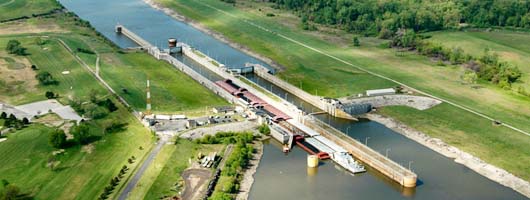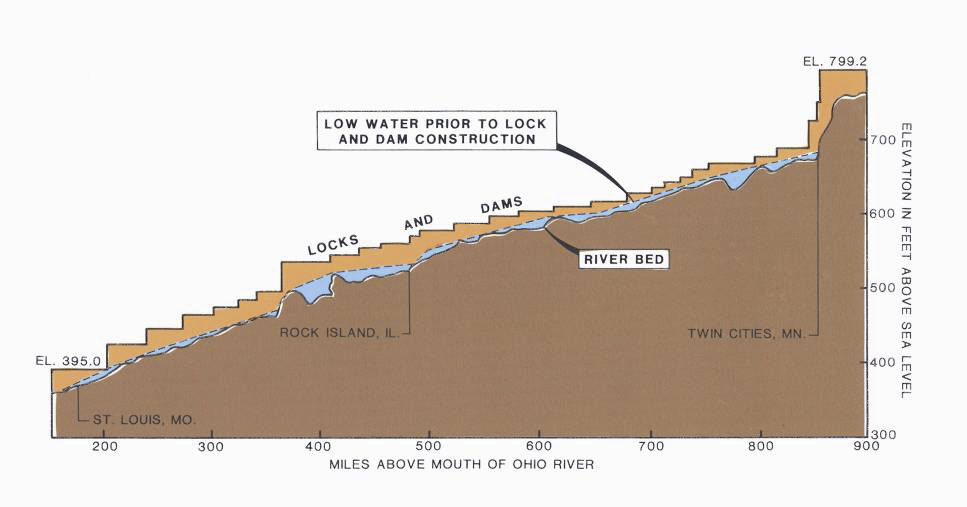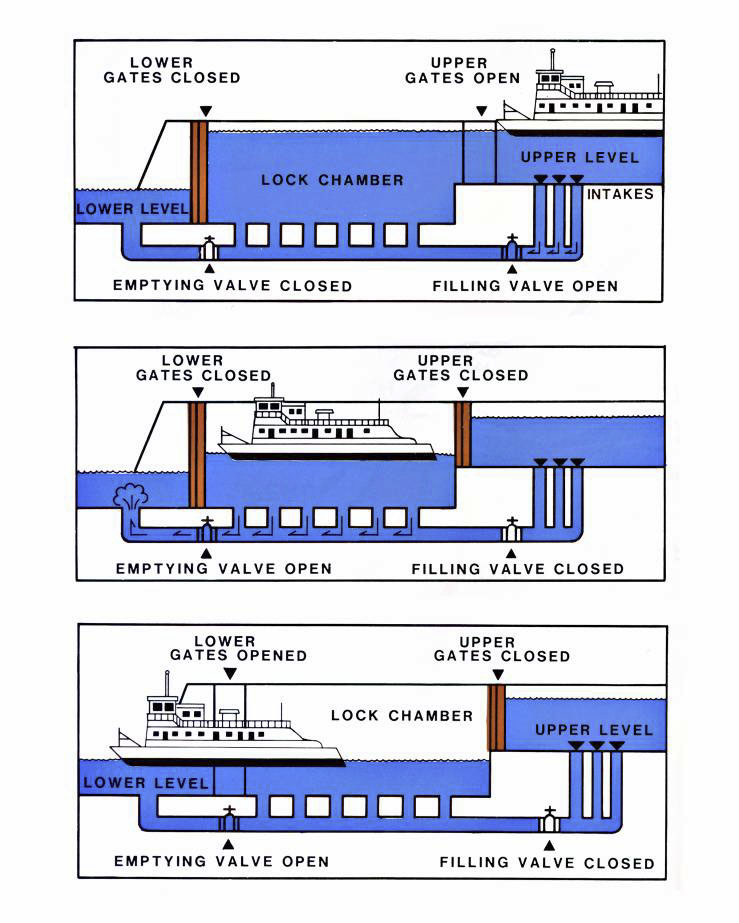
Lock 27
Locks 27 moves more cargo than any other navigation structure on the Mississippi River. The structure is situated near the southern end of the 8.4-mile long, man-made Chain of Rocks Canal. After 1940, only a single impediment prevent the maintenance of a safe and reliable 9-foot navigation channel on the Mississippi River from St. Paul, Minn., to New Orleans. This impediment, known as the Chain of Rocks Reach, was a 17 mile series of rock ledges that began just north of St. Louis and was extremely difficult and dangerous to navigate.
The canal was designed to allow vessels to bypass the treacherous reach. To ensure adequate depths in the pool below the old Lock and Dam 26, a non-moveable, low water dam was constructed across the river, near the old Chain of Rocks bridge. This dam is known as Dam No. 27 and the Chain of Rocks Dam.
Vital Statistics
| Location: | Granite City, Ill. |
|---|---|
| Mississippi River Mile: | 185.5 |
| 1st Day of Operation: | February 7, 1953 |
| Average lift: | 15 feet |
| Pool size: | 13,000 acres |
| Pool length: | 27.8miles |
| Lock characteristics (Main Chamber): |
1,200 feet long 110 feet wide |
| Lock characteristics (Auxiliary Chamber): |
600 feet long 110 feet wide |
| Dam Characteristics: |
2,500-foot long non-movable low-water dam |
| Phone number: | (618) 452-7107 |
| Marine Radio: | 12 |
Nine-Foot Navigation Channel
Located in Granite City, Illinois, Lock and Dam 27 is part of the Upper Mississippi River Nine Foot Navigation Project. The Project, authorized by the Rivers and Harbors Act of 1930, created and ensured a nine-foot deep navigation river channel.
Located in Granite City, Illinois, Lock and Dam 27 is part of the Upper Mississippi River Nine Foot Navigation Project. The Project, authorized by the Rivers and Harbors Act of 1930, created and ensured a nine-foot deep navigation river channel.
Located in Granite City, Illinois, Lock and Dam 27 is part of the Upper Mississippi River Nine Foot Navigation Project. The Project, authorized by the Rivers and Harbors Act of 1930, created and ensured a nine-foot deep navigation river channel.
The Chain of Rocks Canal
In 1940 the Chain of Rocks Reach was the only obstacle that prevented the success of the nine-foot navigation project. This 17 mile stretch of the river was rife with rock ledges that rendered it naturally unnavigable. The Corps built the 8.4 mile long Chain of Rocks Canal to bypass this portion of the River.
Locking Process
The lock chambers consist of 2 miter gates, one vertical lift gate, and four valves (two at each end). All boats wishing to pass through a dam must lock through the lock chamber, even during open river conditions when there is only a 10 or 12 inch difference between the upper and lower pools. Lockage is completed by using a system of valves to raise and lower the water level in the lock chamber. The filling valves are opened to allow water to enter the chamber, making it the same height as the upper pool, and the emptying valves are opened to allow water to drain out, making the chamber the same height as the lower pool. There are two sets of valves, the filling valves (located at the upper pool) and the emptying valves (located at the lower pool). During the process, no pumps are used, the chamber is operated solely on gravity. This is an elevator system for boats. Raising and lowering the water adjusts the boat to the necessary pool level. Without the locks the boats would face a drop of as much as 20 ft.
Annual Tonnage
| Years | Tonnage | Lockages |
|---|---|---|
| 2009 | 60,534,314 | 8,132 |
| 2008 | 58,218,139 | 7,500 |
| 2007 | 67,714,832 | 8,681 |
| 2006 | 73,361,655 | 8,650 |
| 2005 | 68,369,897 | 7,945 |
| 2004 | 71,169,714 | 8,321
|
2003 |
77,466,308 |
9,133 |
2002
|
83,825,396
|
9,299
|
2001 |
81,090,628 |
9,199 |
2000
|
82,633,959
|
9,124
|
1999 |
83,378,714 |
9,215 |
1998
|
80,746,809
|
8,967
|
1997 |
77,168,006 |
8,860 |
1996
|
79,440,582
|
9,814
|
1995 |
84,423,520 |
9,387 |
1994
|
77,328,058
|
9,403
|
1993 |
67,796,856 |
7,935 |
1992
|
81,463,112
|
10,706
|
1991 |
81,233,688 |
10,954 |
1990
|
85,373,942
|
11,990
|
1989 |
75,352,256 |
11,561 |
1988
|
79,224,302
|
11,753
|
1987 |
78,091,375 |
11,754 |
1986
|
68,362,269
|
10,390
|
1985 |
65,137,963 |
9,368 |
1984
|
76,762,335
|
11,912
|
1983 |
80,844,273 |
12,411 |
1982
|
75,203,822
|
11,330
|
1981 |
76,001,136 |
12,441 |
1980
|
76,394,103
|
12,608
|
1979 |
67,969,250 |
Na |
| 1978 | 68,357,137 | 12,100 |
| 1977 | 64,265,100 | 10,818 |
| 1976 | 64,541,662 | 12,577 |
| 1975 | 58,189,032 | 8,526 |
| 1974 | 56,575,494 | 8,693 |
1973 |
54,416,133 |
8,634 |
1972
|
56,768,448
|
10,571
|
| 1971 | 48,705,045 | 11,912 |
| 1970 | 50,747,918 | 11,353 |
| 1969 | 46,379,053 | 11,003 |
| 1968 | 43,072,743 | 11,196 |
1967 |
43,243,645 |
11,135 |
1966
|
39,821,625
|
10,257
|
1965 |
35,926,212 |
8,884 |
1964
|
32,611,483
|
9,408
|
1963 |
29,916,257 |
8,941 |
1962
|
28,461,788
|
9,266
|
1961 |
24,714,762 |
8,676 |
| 1960 | 22,942,101
|
7,785
|
| 1959 | 22,142,370 |
7,369 |
1958
|
20,358,104
|
6,423
|
1957 |
17,756,706 |
6,124 |
| 1956 | 16,050,793
|
6,270
|
| 1955 | 14,783,744 |
5,452 |
1954
|
12,508,052
|
4,459
|
| 1953 | 8,127,305 |
3,386 |


